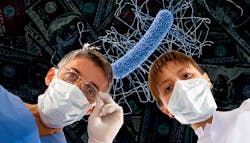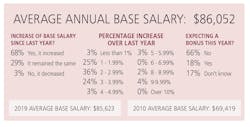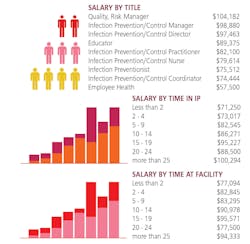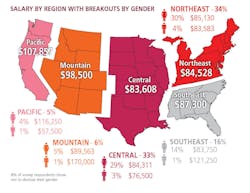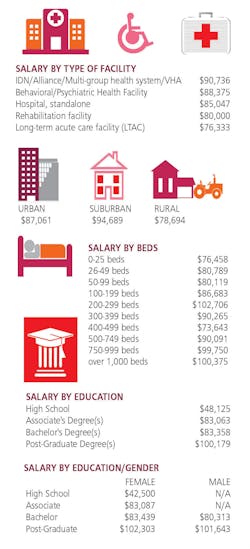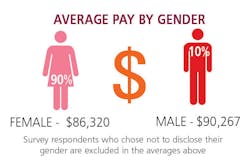Need for IPs outpacing facility efforts to meet benchmarks
With the COVID-19 pandemic dominating headlines, there is no doubt about the critical role that infection prevention/control professionals play in patient care and safety. The 2020 Healthcare Purchasing News Infection Prevention Salary Survey was conducted just prior to the pandemic hitting the U.S. and reveals how infection preventionist (IP) salaries are not keeping pace with increasing demands and expanding roles. Although it will be interesting to see how the COVID-19 crisis impacts this profession in the months and years ahead.
Average IP salary up slightly, more expecting bonuses
In 2020, the IP average annual salary grew marginally, at $86,052 compared with $85,623 in 2019. Fewer IP professionals reported pay increases in 2020 (68 percent) compared with 2019 (72 percent), with the majority (85 percent) reporting raises between 1-4 percent. One positive trend is an increase in bonuses, with 18 percent of those surveyed expecting bonuses in 2020, compared with 13 percent in 2019.
This year’s composite IP is female and she is 52 years old. She is a registered nurse (RN), certified by the Certification Board of Infection Control and Epidemiology (CBIC) and her title is Infection Preventionist. She reports to the VP/Director, Quality/Risk Management/Chief Quality Officer. She has been in infection prevention an average of 12 years and has worked at her current facility for nine years. She is employed at a nonprofit, standalone facility with 234 beds. There are four employees in her department.
Some IP roles see sharp pay increases, others decreases
Among those surveyed, significant pay increases over 2019 were reported among those holding titles in Employee Health (77 percent increase), Infection Prevention/Control Nurse (26 percent increase) and Quality/Risk Manager (19 percent increase). The average annual salary of IP/IC Practitioners dropped by 25 percent, and the average IP/IC Director salary was down by 10 percent.
Job security and recognition
Among those surveyed, less than half (47 percent) said they felt “very secure” in their jobs, down 7 percent compared with 2019. IP professionals who believe their facility’s C-Suite appreciates and understands their role in providing good patient care while managing costs was also slightly lower compared with last year, from 55 percent in 2019 down to 51 percent in 2020.
When asked if their facility’s IP-per-patient ratio is aligned with current Centers for Disease Control and Prevention (CDC) recommendations (1:100), only 35 percent of those IPs surveyed said they were in alignment, which is down for the second year in a row. This is in contrast to recent research which has shown that actual IP labor needs are on the rise.
One study published in the American Journal of Infection Control (AJIC), the journal of the Association for Professionals in Infection Control and Epidemiology (APIC), revealed that actual IP labor needs were 31 to 66 percent higher than the current benchmarks. The revised benchmark, 1.0 IP full-time equivalent (FTE) per 69 beds, considers IP oversight for all physical locations including ambulatory, long-term care and home care settings.1
“I would think the pandemic cements the need for knowledgeable IPs in every type of healthcare facility,” Perri added.
Education and location matter
The majority of this year’s survey respondents hold Bachelor’s degrees (52 percent), followed by post-graduate degrees (27 percent), Associate’s degrees (15 percent) and high school diplomas (5 percent). As in past years, the level of higher education correlated with salary levels, with those holding post-graduate degrees earning the most ($100,179), and those with high school diplomas earning the least ($48,125).
With regards to facility type, IPs working in IDN/alliance/multi-group health facilities earned the most ($90,736/year), followed by those working in behavioral/psychiatric health facilities ($88,375/year). IPs employed by long-term acute care facilities (LTAC) reported the lowest pay level ($76,333/year).
IP professionals working in suburban areas reported the highest annual salaries ($94,689 average). IPs in the Pacific region of the U.S. earn the highest pay on average ($107,857), as in previous years.
Certification and training
The percentage of IPs surveyed who are certified by the CBIC was down compared with last year, from 54 percent in 2019 to 35 percent in 2020. There were also fewer IPs who are registered nurses, down 75 percent in 2019 to 49 percent in 2020.
The results of a CBIC marketing research study found those IPs who were certified “demonstrated professional competency and increased career growth.” Those surveyed also reported that “certification improved the practice of IPC, as well as improved patient care and patient safety.” On the other hand, respondents “were less positive as to whether certification would lead to monetary compensation and an increase in organizational recognition.” 2
Roles and responsibilities
The majority of IPs surveyed (33 percent) said they report directly to the VP/Director, Quality/Risk Management/Chief Quality Officer, followed by VP/Director/Manager/Chief Nursing Officer (CNO) (21 percent), CEO/COO/CFO/Hospital Administration (15 percent) and Director/Manager Infection Prevention (12 percent).
Fewer IPs reported spending 100 percent of their work time in infection prevention, which could indicate that the IP’s role is expanding. In 2020, only 32 percent of those surveyed said all of their time was spent in IP, compared with 46 percent in 2019. The most reported work categories for IPs outside of infection prevention are: National Healthcare Safety Network (NHSN) (27 percent), employee/occupational health (23 percent), education/compliance (18 percent), quality performance management (15 percent), disaster/bioterrorism preparedness (13 percent) and patient safety (12 percent).
With the shift to value-based purchasing and payments, including payment reductions under the Centers for Medicare & Medicaid Services (CMS) Hospital-Acquired Condition (HAC) Reduction Program, healthcare organizations need IPs to take an active role in product selection. The majority of IPs surveyed (63 percent) said they are members of product evaluation committees.
With regards to their role in product evaluation, the highest response percentages were determining the need for a product (56 percent), product safety evaluation (50 percent), process improvement (45 percent) and product testing (42 percent).
Trends and Technologies
Each year Healthcare Purchasing News surveys IPs on some of the latest trends and technologies impacting their role in patient care and safety. Below is a summary of this year’s findings.
Antimicrobial stewardship and prescription safety
On September 30, 2019, CMS published a final rule that requires all critical access hospitals (CAH) that participate in Medicare or Medicaid to develop and implement an antibiotic stewardship program. The rule states:
“The CAH must have active facility-wide programs, for the surveillance, prevention, and control of HAIs and other infectious diseases and for the optimization of antibiotic use through stewardship. The programs must demonstrate adherence to nationally recognized infection prevention and control guidelines, as well as to best practices for improving antibiotic use where applicable, and for reducing the development and transmission of HAIs and antibiotic-resistant organisms. Infection prevention and control problems and antibiotic use issues identified in the programs must be addressed in coordination with the facility-wide quality assessment and performance improvement (QAPI) program.”3
Among those that took part in the 2020 Healthcare Purchasing News Infection Prevention Salary Survey, 89 percent said their facilities had established an antimicrobial stewardship program, and 61 percent said the program has been effective in reducing infection rates, up from 49 percent in 2019. The majority of IPs surveyed also said their facilities follow a safe prescription program (80 percent).
Handwashing and disinfection trends
The COVID-19 outbreak has demonstrated the critical importance of good hand hygiene like never before, in healthcare settings all the way down to individuals in their homes. A higher number of IPs reported that their facilities have instituted or planned to adopt a hand-washing surveillance program compared with last year, from 45 percent in 2019 to 54 percent in 2020. Future surveys will reveal whether COVID-19 will spur more healthcare facilities to adopt hand-washing surveillance programs given the critical nature of effective hand hygiene in reducing spread of the virus.
Nearly half of those surveyed (48 percent) said their facilities are using a data mining software program to track, report and analyze infection trends, down slightly from last year (54 percent).
Fewer respondents this year said their facility used or was planning to use a room disinfection system (27 percent in 2020 versus 32 percent in 2019). While only 11 percent of respondents said their facility instituted or planned to adopt a program aimed at disinfecting electronics (tablets, smartphone, laptops), an additional 33 percent said they were considering such a program, with both figures similar to last year’s survey findings.
Conclusion
While the roles and responsibilities of IPs are expanding and salaries are growing within some of the profession’s categories, overall compensation, recognition and job security have not kept pace. This could change significantly with the COVID-19 pandemic, as healthcare organizations, regulatory bodies, government agencies, professional associations, manufacturers, consumers and other stakeholders are confronted straight on with the rapid spread of this highly contagious and deadly virus. Right now, IPs throughout the U.S. are on the frontlines of battling the epidemic, which could lead to greater respect for the profession, and higher compensation commensurate to the value they bring to healthcare delivery.
References:
1. New studies illustrate need for rigorous review of infection preventionist staffing models across healthcare systems, APIC, June 26, 2018, https://apic.org/news/new-studies-illustrate-need-for-rigorous-review-of-infection-preventionist-staffing-models-across-healthcare-systems/
2. Value of certification in infection prevention and control, American Journal of Infection Control (AJIC), October 2019, https://www.ajicjournal.org/article/S0196-6553(19)30397-9/fulltext#sec0005
3. Medicare and Medicaid Programs; Regulatory Provisions To Promote Program Efficiency, Transparency, and Burden Reduction; Fire Safety Requirements for Certain Dialysis Facilities; Hospital and Critical Access Hospital (CAH) Changes To Promote Innovation, Flexibility, and Improvement in Patient Care, CMS, September 30, 2019, https://www.govinfo.gov/content/pkg/FR-2019-09-30/pdf/2019-20736.pdf
About the Author
Kara Nadeau
Senior Contributing Editor
Kara Nadeau is Sterile Processing Editor for Healthcare Purchasing News.
